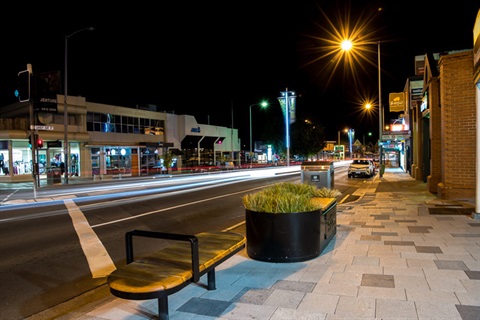Roads and footpaths

Hobart's road network includes:
- 284 kilometres of sealed roads
- 6 kilometres of unsealed roads
- 412 kilometres of footpaths (predominantly asphalt and concrete)
- 67 bridges (mainly of concrete and steel structures)
The City of Hobart has an inspection program that is used to identify hazards, such as:
- uneven footpath surfaces
- damaged signs
- potholes
- trees overhanging the footpath.
If you have a request regarding roads or footpaths, or are aware of a hazard within the road and footpath network, please complete our online form:
Hazard report form
Alternatively, you can phone 03 6238 2711 or email coh@hobartcity.com.au.
Roads that are not managed by City of Hobart
State Government
The following roads within the Hobart municipality are under the management and responsibility of State Government's Department of State Growth:
- Tasman Bridge and Tasman Highway
- Domain Highway, between Tasman Highway and Brooker Avenue
- Brooker Avenue and Brooker Highway
- Davey Street, between Southern Outlet and Brooker Avenue
- Macquarie Street, between Southern Outlet and Brooker Avenue
- Southern Outlet
The City is responsible for the nature strips and footpaths beside most of these state roads except the Southern Outlet, which is a State Government responsibility.
Any enquiries about these roads should be directed to the Department of State Growth.
TasPorts
The Tasmanian Ports Corporation (TasPorts) manage roads on the Hobart Waterfront that are located on pier structures. This includes:
Any enquiries should be directed to TasPorts.
More information
Rights of way
The City is not responsible for rights of way on private land. In general, the maintenance and operation of these private rights of way is the responsibility of the land owner or those who have right of access over the land.
Unsealed roads
There are six (6) kilometres of unsealed roads within Hobart's boundaries. The maintenance and upgrading of these roads is the legal responsibility of the land owners who have frontage onto these roads. However, the City of Hobart grades most unsealed roads twice a year (usually in October and May).
If you have a query regarding unsealed roads or are aware of a hazard on an unsealed road please telephone 03 6238 2711 or email coh@hobartcity.com.au.
Footpath accessibility
The width and standard of the footpaths in the Hobart municipality varies according to the amount of pedestrian use, the geography of the street and the conflicting needs of other road users.
In general, the City of Hobart aims to provide clear pedestrian widths of:
- 1–1.2 metres on low pedestrian volume footpaths in non-commercial areas
- 1.5–1.8 metres on footpaths in commercial areas
- 2.4 metres on high pedestrian volume footpaths (normally in commercial areas).
When appropriate, the City of Hobart permits street trees, advertising signboards, tables and chairs for outdoor dining, and other occupation of the footpath, as long as this does not interfere with the movement of pedestrians.
Utilities infrastructure
Utility and public service authorities install and maintain infrastructure in public road reserves to provide reliable utility services. The utility company or authority that owns the asset is responsible for its maintenance.
These assets can include:
- water and sewage pipes, pits and lids
- telecommunications poles, pits and conduit, cables and cabinets
- electricity poles, cabinets and wires and conduit
- gas pipes and pits
- rail infrastructure like boom gates, signages, ballast and rails
- public transport facilities including bus shelters and tactile ground surface indicators (excluding bus stops in CBD, Lenah Valley and New Town shopping areas which have been installed by the City of Hobart)
- traffic signal infrastructure, including poles, lights, cables, conduit and cabinets.